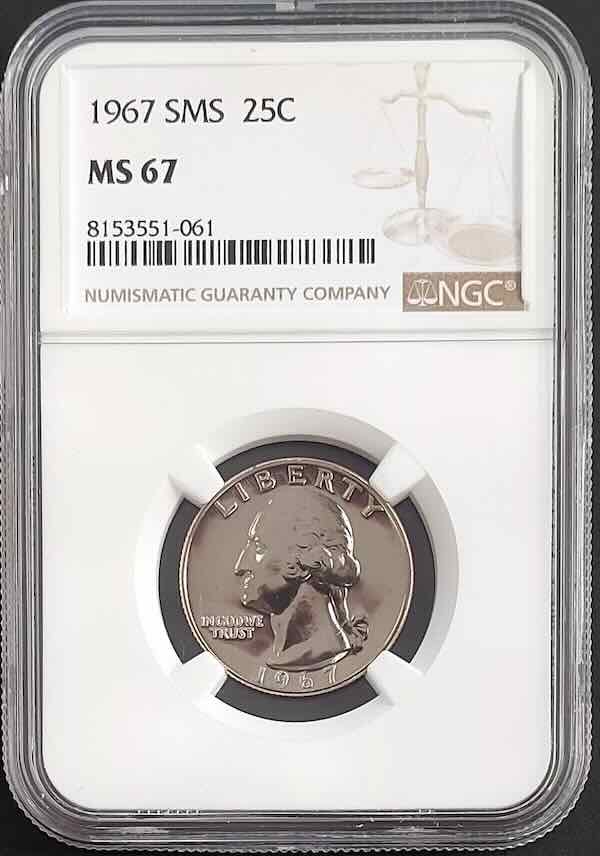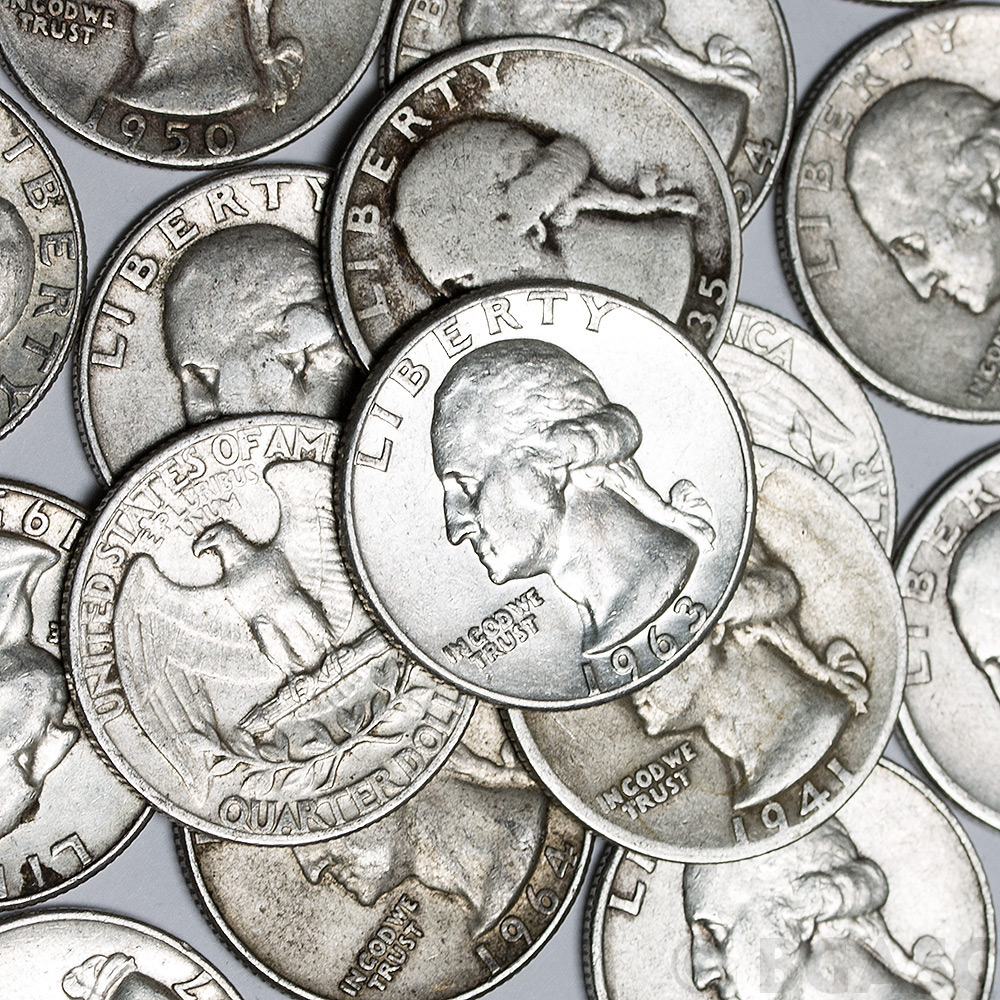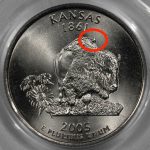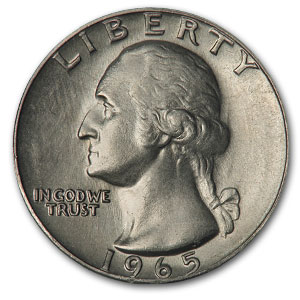The 1964 Washington Quarter is the last quarter struck for circulation containing 90% silver. Its place in numismatic history and the assorted collectible varieties, make it popular among collectors and investors. This guide explores the value of the 1964 Washington Quarter across different variants, including proof coins, error coins, and mint marks.
Due to rising silver prices and economic changes, the U.S. Mint transitioned to a copper-nickel clad composition for quarters starting in 1965, marking the end of the era of silver coins in circulation. The 1964 quarter’s 90% silver content ensures its value exceeds its face value, making it desirable for both silver investors and collectors.
1964 No Mint Mark Quarter
The No Mint Mark 1964 Washington Quarter was issued by the Philadelphia Mint. It features John Flanagan’s depiction of George Washington on the obverse and an eagle clutching arrows and olive branches on the reverse.
1964 No Mint Mark Values
| Grade | Value |
|---|---|
| Good (G-4) to Fine (F-12) | $11.43 (Melt Price) |
| Extremely Fine (EF-40) | $8.00 |
| Mint State (MS-60) | $12.00 |
| Mint State (MS-65) | $25.00+ |
| Highest Auction Record | $12,000 (PCGS MS-67+)* |
In circulated condition, the value of a 1964 no mint mark quarter is tied to its silver content, typically around $6 to $7 depending on the current spot price of silver. Uncirculated examples can fetch $10-$15, while coins graded MS65 or higher by professional grading services can command $50-$100 or more.
1964-D Quarter
Struck at the Denver Mint, the The 1964-D Quarter bears a small “D” mint mark on the reverse, just below the olive branches. Like the Philadelphia-minted quarters, these coins are composed of 90% silver.
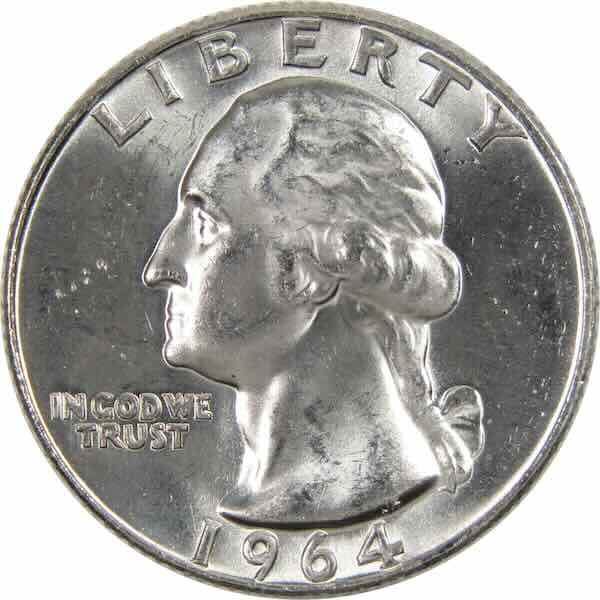
1964-D Values
| Grade | Value |
| Good (G-4) to Fine (F-12) | $11.43 (Melt Price) |
| Extremely Fine (EF-40) | $8.00 |
| Mint State (MS-60) | $12.00 |
| Mint State (MS-65) | $20.00+ |
| Highest Auction Record | $38,400 (PCGS MS-68)* |
Circulated 1964-D quarters are valued for their silver content and generally trade for $6-$7. Uncirculated coins in MS63 to MS64 conditions range from $10-$20, while higher grades such as MS66 or MS67 can sell for $200-$500, especially if they exhibit strong luster and minimal contact marks.
1964 Proof Quarter
Proof quarters were struck at the Philadelphia Mint specifically for collectors. Proof coins are made using polished dies and planchets, resulting in a mirror-like finish and sharp details. The 1964 proof quarter has no mint mark.
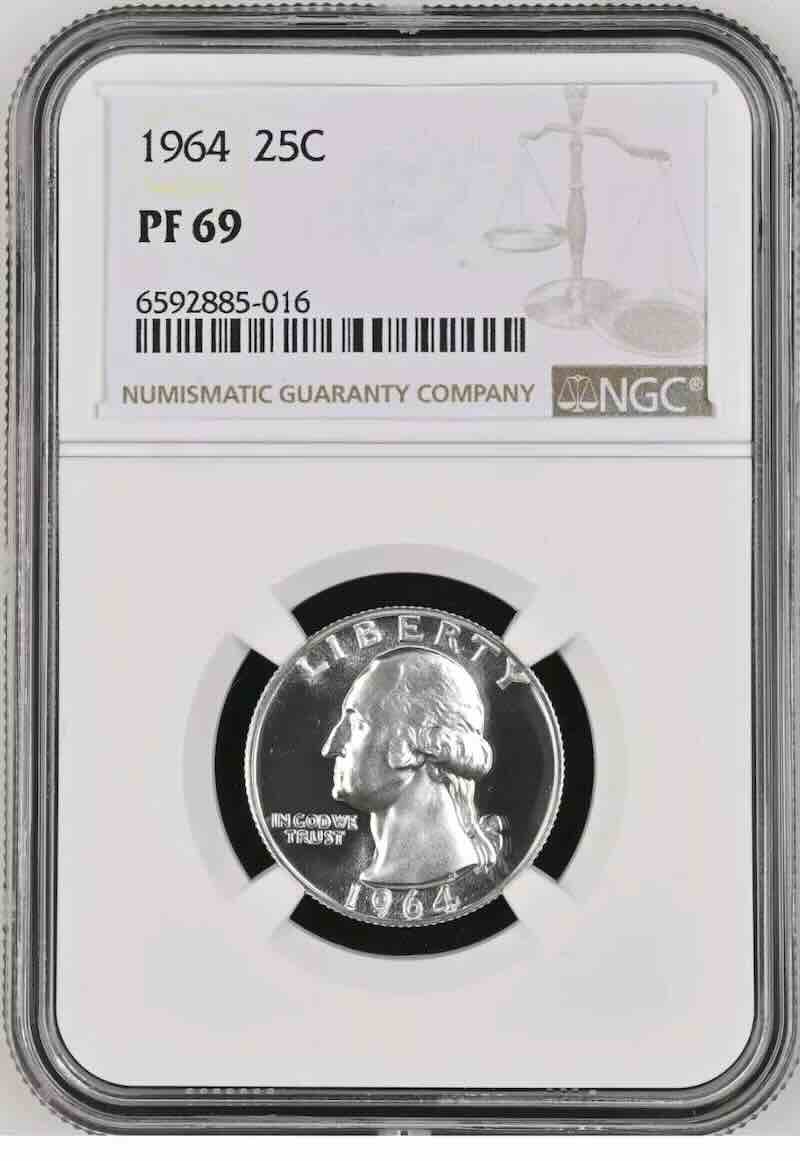
Value
| Grade | Value |
| Proof (PR-60) | $12.00 |
| Proof (PR-65) | $18.00 |
| Proof Cameo (PR-65CAM) | $40.00 |
| Proof Deep Cameo (PR-65DCAM) | $100.00+ |
Proof 1964 quarters are valued higher than circulation-strike coins. Common proof examples typically range from $10-$15. High-grade proofs with deep cameo (DCAM) or ultra cameo (UCAM) contrast can command $50-$150 or more, depending on the grade assigned by grading services like PCGS or NGC.
1964 Quarter Errors
Error coins from 1964 are particularly sought after by collectors due to their rarity and uniqueness. Some of the notable errors include:
- Double Die Obverse (DDO): This error features doubling on the obverse, often noticeable in the lettering or date.
- Off-Center Strikes: These coins show partial designs due to misaligned planchets during striking.
- Planchet Errors: Includes wrong planchet types or clipped planchets.
- Die Cracks and Cuds: Die imperfections resulting in raised lines or blobs on the coin’s surface.
1964 Quarter Error Values
| Error Type | Value Range |
| Doubled Die Obverse | $50 – $500 |
| Off-Center Strike | $20 – $150+ |
| Clipped Planchet | $25 – $100 |
| Other Errors | Varies by type |
Error coin values vary widely based on the type and severity of the error. Common errors like minor die cracks may add $10-$30 to the coin’s value, while significant errors like off-center strikes or double dies can fetch $100-$500 or more depending on their condition and prominence.
Key Factors Affecting 1964 Quarter Value
Condition and Grading
The condition of a coin greatly impacts its value. Circulated quarters are typically valued for their silver content, while uncirculated or graded coins can achieve significantly higher prices. Coins with original mint luster and minimal wear are more desirable.
Silver Content
The intrinsic value of a 1964 quarter is directly linked to its silver content, making it a hedge against inflation or market volatility. Each quarter contains approximately 0.1808 troy ounces of silver.
Collector Demand
Variations like mint marks, errors, and proof coins create distinct niches within the market. High-quality examples of these variants consistently attract collector interest.
Summary Table of 1964 Quarter Values
| Variant | Condition | Approximate Value |
|---|---|---|
| No Mint Mark (Philadelphia) | Circulated | $11.43 (Melt Price) |
| MS63-MS64 | $10-$15 | |
| MS65+ | $50-$100+ | |
| 1964-D (Denver) | Circulated | $11.43 (Melt Price) |
| MS63-MS64 | $10-$20 | |
| MS66-MS67 | $200-$500+ | |
| Proof | Standard Proof | $10-$15 |
| Deep/Ultra Cameo | $50-$150+ | |
| Errors | Minor Errors | $10-$30 |
| Major Errors | $100-$500+ |
Conclusion
The 1964 Washington Quarter remains a cornerstone of U.S. numismatics. Whether valued for its historical significance, silver content, or collectible variants, it offers opportunities for both novice and seasoned collectors. Understanding the nuances of each variant—from proof coins to errors and mint marks—can help you make informed decisions when buying, selling, or adding to your collection. By focusing on condition, rarity, and demand, you can maximize the potential value of your 1964 quarters.
